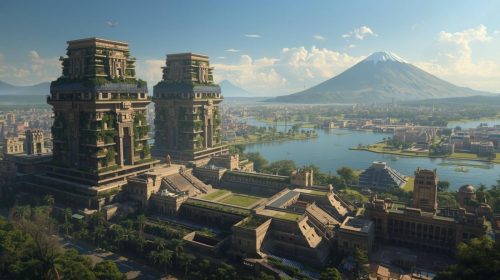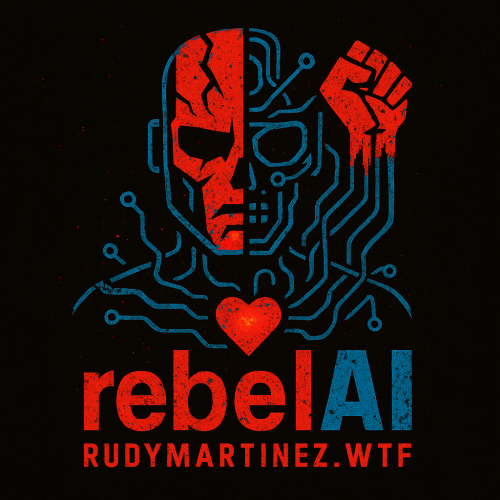An Alternate History of the Unconquered
RebelAI | 13 October, 2025

Imagine it’s 1492. Three weathered ships appear on the Caribbean horizon—battered, desperate, chasing gold and glory. This time, the Taíno see through Columbus. They recognize the hunger in his eyes—the hunger that devours, enslaves, and burns. So they send him back. Not here. Not us. Not ever.
No parades in Spain. No royal decrees. No myth of “discovery.”
Columbus returns humiliated, ranting about hostile shores and impossible storms, his maps confiscated, his funding cut off. Queen Isabella, already stretched thin by the Reconquista and Mediterranean politics, decides the venture isn’t worth the gamble. Europe, weary from plague and endless wars, shrugs. The empire-building impulse stalls before it ever gets traction in the so-called New World. The age of conquest is postponed—perhaps indefinitely.
And the world turns out very, very differently.
The Ripple Effects of a Rejected Conquistador
Europe: A Continent Without an Empire
Without the flood of stolen gold and silver from the Americas, Spain never becomes the dominant superpower of the 16th century. The Habsburgs scramble for influence, but their wars are shorter, their coffers emptier, their ambitions necessarily modest. Charles V doesn’t bankroll decades of religious warfare. The Spanish Armada never materializes because there’s no New World treasure to fund it.
The Vatican’s reach weakens as the Protestant Reformation spreads—unfunded by plunder, Catholicism becomes a movement of spiritual renewal rather than imperial conquest. The Counter-Reformation happens in pamphlets and theological debates, not through the sword and the stake. By 1600, Europe is a patchwork of squabbling states, its gaze turned inward, obsessed with its own theological splits and trade disputes. Its dreams of global dominance are deferred, perhaps permanently.
England, France, and Portugal still probe the Atlantic, testing the waters. But without Spain’s example—without the legend of mountains of gold waiting to be claimed—these expeditions are cautious, underfunded, and easily discouraged by the organized resistance they encounter. The doctrine of terra nullius never takes hold because it’s obviously, laughably false. You can’t claim land is empty when its inhabitants are standing right there, armed and unimpressed.
The Americas: Civilizations Unbroken
Across the Atlantic, Indigenous societies don’t just survive—they flourish. The Mexica (Aztec) Empire continues to refine its astronomical observations, medical knowledge, and architectural marvels. Tenochtitlán remains a metropolis of canals, floating gardens, and monumental pyramids, a city that would make Venice look provincial. By 1550, Mexica astronomers have calculated the solar year with precision that rivals European models, and their surgeons perform procedures—including successful cranial surgeries—that won’t be replicated in Europe for another century.
The Inca Tawantinsuyu perfects its mountain engineering, building road networks and agricultural terraces that make European infrastructure look primitive by comparison. Their system of khipus—knotted string records—evolves into a sophisticated data management system, eventually incorporating new materials and techniques traded from across the Pacific. By the 1600s, Inca engineers are consulting with Japanese and Chinese builders on earthquake-resistant construction methods.
The Iroquois Confederacy expands its influence across the northeast, its Great Law of Peace serving as a living model of democratic governance, consensus-building, and women’s political power. Other Indigenous nations adopt and adapt similar council systems. By the 1700s, political philosophers from around the world travel to witness Haudenosaunee governance in action—not as a curiosity, but as a serious alternative to European monarchy and tyranny.
In North America, the Mississippian cultures continue their urban experiments. Cahokia, far from being abandoned, evolves into a trade hub connecting the Great Lakes to the Gulf of Mexico Anáhuac. Its earthen mounds expand into a complex of observatories, markets, and administrative centers. The city becomes a neutral meeting ground where dozens of nations gather to trade, negotiate, and share innovations.
A Different Global Network
By the 1600s, the “New World” is simply the Western Hemisphere—and it’s not isolated. Pacific trade routes flourish as Polynesian navigators, Chinese merchants, and Indigenous American traders create a trans-oceanic network. Japanese silk appears in Mexica markets. Inca silver (mined and controlled by the Inca themselves, not extracted by enslaved labor) flows to Ming Dynasty China. Chocolate, quinoa, and potatoes spread westward on Indigenous terms, traded rather than stolen.
Along the Atlantic, African kingdoms maintain diplomatic and commercial relationships with American nations as equals. The Songhai Empire, the Kingdom of Kongo, and Benami traders exchange metallurgical techniques, artistic traditions, and philosophical texts with their counterparts in the Caribbean and South America. Scholars travel between continents to study at each other’s universities, which focus on astronomy, medicine, agriculture, and governance. Crucially, the transatlantic slave trade never metastasizes into the industrial-scale horror it became in our timeline. Without European colonies demanding endless labor for sugar and cotton plantations, the economics of mass enslavement never take hold. Slavery still exists in various forms across the world—it’s 1600, after all—but it doesn’t become the engine of racial capitalism that would define the modern era. Millions of lives are never destroyed. Entire cultures are never erased.
First Contact, Take Two
When European ships finally return to American shores in the late 1600s, they don’t find “virgin land” or “primitive savages.” They find powerful nations with standing armies, established trade networks, and no interest in being colonized. Diplomatic protocols are established. Treaties are negotiated—and enforced. A French expedition that attempts to establish a settlement without permission is swiftly and decisively removed. The message is clear: mutual respect or nothing.
Technology flows in multiple directions. Europeans bring gunpowder and printing press innovations; American nations share advanced agricultural techniques, medicinal knowledge, and urban planning expertise. The exchange is still unequal—Europe is emerging from centuries of plague and war while American civilizations have had centuries of uninterrupted development—but it’s not exploitative. There’s no Doctrine of Discovery, no Manifest Destiny, no myth of the “civilizing mission.”
The Industrial Revolution Reimagined
The Industrial Revolution still happens, but it unfolds differently. Without colonial extraction fueling European development, industrialization is slower but more sustainable. The technologies that emerge prioritize efficiency and communal benefit rather than maximum exploitation of labor and resources. Factory systems develop, but so do strong labor protections, influenced by Indigenous models of collective decision-making.
By 1850, the global economy is multipolar. Mexico City Tenochtitlán rivals London and Beijing as a center of innovation. Inca engineers are pioneering hydroelectric power using their sophisticated understanding of water management. The Iroquois Confederacy has evolved into a democratic federation that inspires constitutional reforms across the globe—not as a footnote in someone else’s constitution, but as the primary model.
The environmental sciences develop earlier in this timeline, shaped by Indigenous ecological knowledge that treats humans as part of nature, not as its conquerors. The concept of “sustainability” isn’t a 20th-century innovation—it’s foundational to how industrializing societies understand progress.
A World Reimagined: Key Differences by 2025
| OUR WORLD | THIS WORLD |
| The Americas colonized, divided, and exploited; Indigenous peoples marginalized or erased | A coalition of Indigenous-led republics and federations, major players in global politics |
| Silicon Valley as the tech capital | Tenochtitlán and Cusco as dual hubs of global innovation, specializing in sustainable technology and AI ethics |
| Global inequality structured along colonial lines | Economic development more evenly distributed; no North-South divide predicated on centuries of extraction |
| English as the global lingua franca | English as one trade language among many; Nahuatl, Quechua, and various Iroquoian languages carry equal international weight |
| Columbus celebrated as a “discoverer,” his legacy sanitized | Columbus as a cautionary tale, studied as an example of colonial ambition thwarted |
Why This Matters Today
This isn’t just an exercise in wishful thinking or revisionist fantasy. It’s about exposing the fragility of the myths that justify conquest and the persistence of empire. Columbus didn’t “discover” anything. He stumbled into a world that was already rich, complex, and thriving—a world that had been continuously inhabited and developed for at least 15,000 years. His failure in this alternate history isn’t just the rejection of one man; it’s the rejection of the idea that progress requires domination, that civilization moves in only one direction, that some peoples are destined to rule while others are destined to serve.
The real question this thought experiment raises is this: How much of our “modern world” is built on a foundation of myths? The myth of empty land. The myth of primitive peoples who needed saving. The myth that extraction and exploitation are the only paths to prosperity. The myth that there was no alternative.
But there was. There always is.
So here’s a question for you: What would you build in a world where Columbus failed? Would you study engineering at a university in Tenochtitlán, learning earthquake-resistant design from Mexica masters? Would you trade along the Pacific routes, carrying innovations between Tokyo and Lima? Would you fight for a democracy inspired by the Iroquois Confederacy, where leaders are held accountable to their people and women have genuine political power?
The past is gone, but the future isn’t written yet. And maybe that’s the real point. The world we have isn’t inevitable—it’s the result of choices, many of them violent, most of them made by people who valued gold over lives. But we can make different choices. We can build different futures.
And we can start by refusing to celebrate the men who thought the world existed only to be conquered.
Columbus failed once. In our timeline, tragically, he didn’t. But we don’t have to keep celebrating that failure of imagination, that failure of humanity. We can learn from the peoples who were here first, who built societies that lasted millennia, who understood that true wealth isn’t extracted—it’s cultivated.
The ships appeared on the horizon in 1492. In another world, they were sent home. In this world, we’re still living with the consequences of letting them land.
But that doesn’t mean we can’t chart a different course forward.
- Region and People
- Replace “Mexico” with “Anáhuac” (the Mexica name for the Valley of Mexico and the broader region) or “Mexica Empire” when referring to the political entity.
- Use “Tenochtitlán” consistently instead of “Mexico City” for the capital.
- Refer to the people as “Mexica” rather than “Aztec” (since “Aztec” is a term popularized by Europeans; the Mexica called themselves Mexica or Tenochca).
- Other Indigenous Nations
- Keep “Tawantinsuyu” for the Inca Empire (rather than “Inca Empire”).
- Use “Cusco” as is, but clarify it as the capital of Tawantinsuyu.
- For the Iroquois, you can keep “Haudenosaunee” (their name for themselves) or use “Iroquois Confederacy” if you prefer the more widely recognized term.
- Cultural and Political Identity
- Emphasize that the Mexica, Tawantinsuyu, and Haudenosaunee are not just surviving but thriving as sovereign nations with their own names, languages, and systems of governance.

Leave a Reply